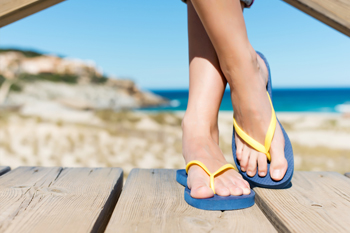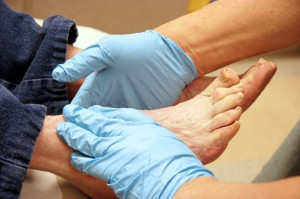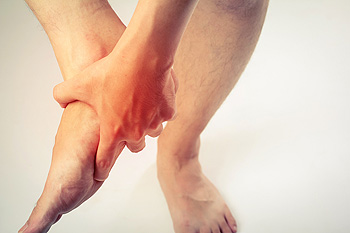May 2021
How Diabetes Can Affect the Feet
It is well known that diabetes affects blood sugar and one’s overall health, but did you know that it can affect your feet too? Diabetes can cause peripheral neuropathy, a type of nerve damage in the feet that can lead to a loss of sensation. Diabetes also affects blood flow throughout the body and often leads to poor blood flow to the feet. Neuropathy can make it difficult to detect foot injuries, such as sores, scrapes, or wounds, and poor circulation can make these injuries slow to heal and prone to infection. When left untreated serious complications may occur. Signs that diabetes is affecting your feet include foot swelling, discoloration, burning or tingling sensations, numbness, and loss of hair on the toes and legs. If you have diabetes or notice any of these symptoms in your feet, it is suggested that you seek the care of a podiatrist who can help you manage proper foot health.
Diabetic foot care is important in preventing foot ailments such as ulcers. If you are suffering from diabetes or have any other concerns about your feet, contact one of our podiatrists from Advanced Foot & Ankle Associates, PLLC. Our doctors can provide the care you need to keep you pain-free and on your feet.
Diabetic Foot Care
Diabetes affects millions of people every year. The condition can damage blood vessels in many parts of the body, especially the feet. Because of this, taking care of your feet is essential if you have diabetes, and having a podiatrist help monitor your foot health is highly recommended.
The Importance of Caring for Your Feet
- Routinely inspect your feet for bruises or sores.
- Wear socks that fit your feet comfortably.
- Wear comfortable shoes that provide adequate support.
Patients with diabetes should have their doctor monitor their blood levels, as blood sugar levels play such a huge role in diabetic care. Monitoring these levels on a regular basis is highly advised.
It is always best to inform your healthcare professional of any concerns you may have regarding your feet, especially for diabetic patients. Early treatment and routine foot examinations are keys to maintaining proper health, especially because severe complications can arise if proper treatment is not applied.
If you have any questions please feel free to contact one of our offices located in Lake Worth and Aledo/Willow Park, TX . We offer the newest diagnostic and treatment technologies for all your foot and ankle needs.
Plantar Warts Can Be Treated!
Should I See a Podiatrist or a Pedorthist?
 A podiatrist is a doctor that specializes in treating foot and ankle problems. A pedorthist is a footwear specialist that creates or modifies shoes, socks, and orthotics that aid in management and recovery from various foot problems. You should see a podiatrist if you have a foot or ankle injury, infection, deformity, biomechanical abnormality, or if you have a systemic disease, like diabetes, which can affect the lower limbs. You should see a pedorthist if you need footwear modifications, custom orthotics, or a foot analysis. If your podiatrist diagnoses a foot problem that requires orthotics or footwear changes to treat it, they may refer you to a pedorthist. If you are experiencing foot or ankle pain, please seek the care of a podiatrist.
A podiatrist is a doctor that specializes in treating foot and ankle problems. A pedorthist is a footwear specialist that creates or modifies shoes, socks, and orthotics that aid in management and recovery from various foot problems. You should see a podiatrist if you have a foot or ankle injury, infection, deformity, biomechanical abnormality, or if you have a systemic disease, like diabetes, which can affect the lower limbs. You should see a pedorthist if you need footwear modifications, custom orthotics, or a foot analysis. If your podiatrist diagnoses a foot problem that requires orthotics or footwear changes to treat it, they may refer you to a pedorthist. If you are experiencing foot or ankle pain, please seek the care of a podiatrist.
If you are experiencing pain in the feet or ankles, don’t join the stubborn majority refusing treatment. Feel free to contact one of our podiatrists from Advanced Foot & Ankle Associates, PLLC. Our doctors can provide the care you need to keep you pain-free and on your feet.
What Is a Podiatrist?
Someone would seek the care of a podiatrist if they have suffered a foot injury or have common foot ailments such as heal spurs, bunions, arch problems, deformities, ingrown toenails, corns, foot and ankle problems, etc.
Podiatric Treatment
A podiatrist will treat the problematic areas of the feet, ankle or lower leg by prescribing the following:
- Physical therapy
- Drugs
- Orthotic inserts or soles
- Surgery on lower extremity fractures
A common podiatric procedure a podiatrist will use is a scanner or force plate which will allow the podiatrist to know the designs of orthotics. Patients are then told to follow a series of tasks to complete the treatment. The computer will scan the foot a see which areas show weight distribution and pressure points. The podiatrist will read the analysis and then determine which treatment plans are available.
If you have any questions please feel free to contact one of our offices located in Lake Worth and Aledo/Willow Park, TX . We offer the newest diagnostic and treatment technologies for all your foot and ankle needs.
Flip Flops Are Hard on Your Feet
 Flip flops may be easy to slip on and look great with casual outfits, but they are not great for everyday footwear, partly because they change the way you walk. Flip flop wearers take smaller steps, which puts more stress on the body and may lead to pain in joints and muscles. To keep flip flops on, people tend to scrunch up the toes, which limits muscle movement and causes you to shuffle your feet more than if you were wearing traditional shoes. The flat sole and lack of support of flip flops can cause heel pain and even plantar fasciitis—especially for those who are overweight. Flip flops have their place on the beach, at the poolside, or in the locker room, but give your feet a break and limit the time you wear them. Check with a podiatrist if you have any pain in the heel or the foot, and for suggestions on the most appropriate footwear to avoid injury.
Flip flops may be easy to slip on and look great with casual outfits, but they are not great for everyday footwear, partly because they change the way you walk. Flip flop wearers take smaller steps, which puts more stress on the body and may lead to pain in joints and muscles. To keep flip flops on, people tend to scrunch up the toes, which limits muscle movement and causes you to shuffle your feet more than if you were wearing traditional shoes. The flat sole and lack of support of flip flops can cause heel pain and even plantar fasciitis—especially for those who are overweight. Flip flops have their place on the beach, at the poolside, or in the locker room, but give your feet a break and limit the time you wear them. Check with a podiatrist if you have any pain in the heel or the foot, and for suggestions on the most appropriate footwear to avoid injury.
Flip-flops can cause a lot of problems for your feet. If you have any concerns about your feet or ankles, contact one of our podiatrists from Advanced Foot & Ankle Associates, PLLC. Our doctors will assist you with all of your foot and ankle needs.
Flip-Flops and Feet
Flip-flops have managed to become a summer essential for a lot of people. While the shoes may be stylish and easy to slip on and off, they can be dangerous to those who wear them too often. These shoes might protect you from fungal infections such as athlete’s foot, but they can also give you foot pain and sprained ankles if you trip while wearing them.
When Are They Okay to Wear?
Flip-flops should only be worn for very short periods of time. They can help protect your feet in places that are crawling with fungi, such as gym locker rooms. Athlete’s foot and plantar warts are two common fungi that flip-flops may help protect your feet against.
Why Are They Bad for My Feet?
These shoes do not offer any arch support, so they are not ideal for everyday use. They also do not provide shock absorption or heel cushioning which can be problematic for your feet. Additionally, you may suffer from glass cuts, puncture wounds, and stubbed toes since they offer little protection for your feet.
More Reasons Why They Are Bad for Your Feet
- They Slow You Down
- May Cause Blisters and Calluses
- Expose Your Feet to Bacteria
If you have any questions, please feel free to contact one of our offices located in Lake Worth and Aledo/Willow Park, TX . We offer the newest diagnostic and treatment technologies for all your foot care needs.
What Does Cuboid Syndrome Feel Like?
Cuboid syndrome is a condition in which the cuboid bone, located in the middle of the foot, becomes misaligned due to injury. This can cause sharp pain on the outer side of the foot, as well as underneath the foot. The pain can come on suddenly and gradually worsen while you walk or stand, but can be relieved by taking weight off of the affected foot. You may also notice mild swelling along the outside of the foot. The symptoms of cuboid syndrome can make it difficult or impossible to walk, and pain can persist for days or even weeks. If you are experiencing foot pain, it is strongly suggested that you seek the care of a podiatrist, who can diagnose and treat your condition.
Cuboid syndrome, also known as cuboid subluxation, occurs when the joints and ligaments near the cuboid bone in the foot become torn. If you have cuboid syndrome, consult with one of our podiatrists from Advanced Foot & Ankle Associates, PLLC. Our doctors will assess your condition and provide you with quality foot and ankle treatment.
Cuboid syndrome is a common cause of lateral foot pain, which is pain on the outside of the foot. The condition may happen suddenly due to an ankle sprain, or it may develop slowly overtime from repetitive tension through the bone and surrounding structures.
Causes
The most common causes of cuboid syndrome include:
- Injury – The most common cause of this ailment is an ankle sprain.
- Repetitive Strain – Tension placed through the peroneus longus muscle from repetitive activities such as jumping and running may cause excessive traction on the bone causing it to sublux.
- Altered Foot Biomechanics – Most people suffering from cuboid subluxation have flat feet.
Symptoms
A common symptom of cuboid syndrome is pain along the outside of the foot which can be felt in the ankle and toes. This pain may create walking difficulties and may cause those with the condition to walk with a limp.
Diagnosis
Diagnosis of cuboid syndrome is often difficult, and it is often misdiagnosed. X-rays, MRIs and CT scans often fail to properly show the cuboid subluxation. Although there isn’t a specific test used to diagnose cuboid syndrome, your podiatrist will usually check if pain is felt while pressing firmly on the cuboid bone of your foot.
Treatment
Just as the range of causes varies widely, so do treatments. Some more common treatments are ice therapy, rest, exercise, taping, and orthotics.
If you have any questions, please feel free to contact one of our offices located in Lake Worth and Aledo/Willow Park, TX . We offer the newest diagnostic and treatment technologies for all your foot care needs.
Blog Archives
- April 2025
- March 2025
- February 2025
- January 2025
- December 2024
- November 2024
- October 2024
- September 2024
- August 2024
- July 2024
- June 2024
- May 2024
- April 2024
- March 2024
- February 2024
- January 2024
- December 2023
- November 2023
- October 2023
- September 2023
- August 2023
- July 2023
- June 2023
- May 2023
- April 2023
- March 2023
- February 2023
- January 2023
- December 2022
- November 2022
- October 2022
- September 2022
- August 2022
- July 2022
- June 2022
- May 2022
- April 2022
- March 2022
- February 2022
- January 2022
- December 2021
- November 2021
- October 2021
- September 2021
- August 2021
- July 2021
- June 2021
- May 2021
- April 2021
- March 2021
- February 2021
- January 2021
- December 2020
- November 2020
- October 2020
- September 2020
- August 2020
- July 2020
- June 2020
- May 2020
- April 2020
- March 2020
- February 2020
- January 2020
- December 2019
- November 2019
- October 2019
- September 2019
- August 2019
- July 2019
- June 2019
- May 2019
- April 2019
- March 2019
- February 2019
- January 2019
- December 2018
- November 2018
- October 2018







